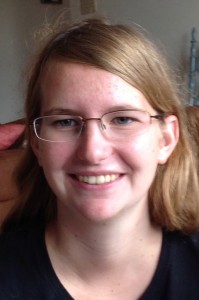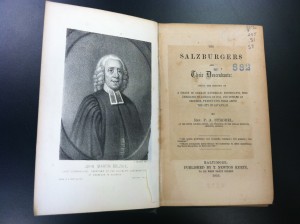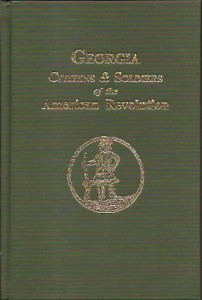By: Annemarie Lisko, UA undergraduate
This is the fourth post of a five-part series on Dr. Cardon’s English 103 classes and their project using Special Collections materials to create a physical display for exhibition in the W.S. Hoole Library Lobby. Read the first and second posts which provide an overview of the class and project. Yesterday, we published Lisko’s piece for the show. On Monday, we’ll cover the exhibition reception.
Congratulations on having your work chosen to be featured on Cool@Hoole! To start with, can you summarize why you decided to focus on the particular part of your family that you featured in your display?
I had heard my grandmother refer to the history of her side of the family a couple of times in the past, and I knew that she had done research on that topic. So when Dr. Cardon first introduced the assignment, I called my grandma right away, because I thought that maybe she could give me some advice about a starting point for the project.
She started telling me this fascinating story about the Georgia Salzburgers—Lutheran Protestants from Salzburg and the surrounding lands—who fled their country in the 1700s because of religious persecution and then settled in Georgia, founding a town called Ebenezer…Her ancestors were among those people.
I was intrigued because I had never heard of the Georgia Salzburgers before. Furthermore, the idea that some of my ancestors have been here, in the South, for more than two hundred years, grabbed my attention. I was curious to find out the precise details of why and how they ended up here. So I chose to do my exhibit on the Gnann family (George and Anna, and their sons Andrew, Michael, and Jacob), who came from Langenau, Germany to Ebenezer, Georgia in 1751, as part of the Georgia Salzburger movement.
Did you consider other topics for your display? Or was this the part of your family’s history you immediately felt would work the best?
Really, once I had learned just a little bit about the Gnanns, I was convinced that they were going to be my topic. I find their story—and that of the Georgia Salzburgers in general—to be extremely interesting and moving.
Had you heard of or visited a special collections repository before you came to the W.S. Hoole Library?
Actually, I had never heard of or visited a special collections library before I came to Hoole. However, since being introduced to the Hoole library in October, I have been back about five times.
What was your first impression of Hoole?
I loved it! I really love all things history-related, and so Hoole is like a dream for me. Just being in the presence of so many historical documents and objects is absolutely fantastic!
How did you conduct your research for this paper?
I started with the information my grandma gave me during our phone conversation—the names of multiple Gnann family members (along with some dates of birth), the name of the town in Germany where they lived before coming to America, and a small bit of background on the Georgia Salzburger movement in general.
To begin with, I drew up a very basic family tree from the names my grandma had given me. She had told me the names of our direct ancestors all the way back into the 1500s—fifteen generations—so the chart ended up being pretty big. I wrote it on a two sheets of notebook paper taped together, because I didn’t have enough room on just one page.
Then I entered some of those names into Ancestry.com, and I found that a few other people had created family trees containing those same ancestors. I compared my chart to multiple other Gnann family trees, which was really helpful—I had the opportunity to check my information against several other people’s research, and I was able to fill in a few blanks on my tree, such as missing dates of birth.
From a post on Ancestry, I found my first outside resource. Someone on the website mentioned that a book called Georgia Citizens and Soldiers of the American Revolution contained references to Jacob Gnann. As luck would have it, Gorgas Library owns a copy of that book, so I ran right over and checked it out. Sure enough, the book lists Jacob Gnann—one of George Gnann’s sons, who was two years old when the family came to America—as a member of the Georgia military during the war.
Then, by Google-searching “Gnann” and “Revolutionary War,” I found out that the names of both Jacob Gnann and Andrew Gnann are listed on the Revolutionary War section of a veterans’ memorial wall near Ebenezer.
A few days later, I found the 1855 history book The Salzburgers and Their Descendants at the Hoole library. The book contains, among other pieces of information, a transcription of the signatures of the congregation of the Jerusalem Lutheran Church in Ebenezer. The document is dated 1775, and it includes the names of George, Andrew, and Jacob Gnann. I reference that book in my essay, and I also include a picture of the church itself—it was built in 1769 and it is still there today.
I then came across Hoole’s beautiful German Bible from 1700 while searching combinations of keywords like “German” and “Lutheran” in the UA library databases on the day that our English class had a research session at Special Collections. When I saw that the book was an actual Lutheran Bible, printed in Germany in 1700, I realized that it could be really significant for my project—it was the same kind of Bible that my ancestors and the others who fled to Georgia during as part of the Georgia Salzburger movement might have read!
To gain additional familiarity with the story of the Georgia Salzburgers, I consulted multiple sources, including the website of the Georgia Salzburger Society, other historical websites, and even a copy of the actual Edict of Expulsion that was issued against the Salzburger Protestants in 1731.
Finally, my grandma—Mrs. Davey Gnann Volkhardt—gave me an immense amount of help in my research. In addition to offering me a multitude of advice over the phone, she mailed me two boxes full of books that she had used in her own research. The books, which included chronicles of numerous Georgia Salzburger families, records from Effingham County (in which Ebenezer is located), and information on and photographs of many members of the Gnann family, were extremely valuable to my research.
How was this type of research assignment different from the kinds of research you’ve done before?
I think that the biggest difference was that, for this project, I really had to find and put together my own resources. For nearly every other topic I’ve ever researched or written about before–Harper Lee, World War I, the Beatles, those sorts of things—a multitude of readily available reference material exists. But the Gnann family from Langenau, Germany?…There is no concentrated source of information about them. I had to piece together little bits of information from all over the place–a ship record that included their names, a newspaper article that mentioned the ship, a book that mentioned Jacob Gnann’s military service, a monument that confirms that fact, a book that lists the Gnanns as members of the Jerusalem Lutheran church, a website that features a picture of the church, references to the Edict of Expulsion on numerous websites, one website that features the actual document…
The process was like putting together a puzzle—sometimes all the pieces just dropped into place exactly as I needed them, other times nothing presented itself at all, and yet other times the process crept along at a slow but steady pace…The experience ran the whole spectrum—exhilarating, frustrating, exhilarating again, and ultimately it was incredibly satisfying. I am so excited that I was able to find out all the information that I did, and I am really, really grateful for all the help I received, which enabled me to put the whole project together.
What did you most enjoy about your research at Hoole?
What I loved the most was getting to actually handle such old and historical artifacts. I was incredibly excited to find an 1853 history book (The Salzburgers and Their Descendants) at Hoole, and seeing my ancestors’ names in there was quite an intense experience. I think that being able to physically interact with the items adds a whole new level of depth to the research process.
One of my favorite moments during my Hoole research was something that happened while I was looking at the German Bible. I had learned that the Salzburgers had chosen the name of their town—Ebenezer—from a Bible verse, and I decided to see if I could find it in the Bible at Hoole. However, not only was I unsure of exactly where in the Bible that particular verse is, but also I cannot speak, read, or understand German.
However, after a very long time, with a lot of guesswork and a great deal of help from Google Translate, I was able to find and read the verse. It was really thrilling—one minute I was staring at line after line of ornate 18th century German text, and then all of sudden I saw the word Ebenezer on the page, and I realized “This is it!” Seeing that verse, in German, in a Lutheran Bible from Germany from 1700, helped me feel really close to the Gnanns’ story.
What would you tell other undergraduate students asked to do what you did, which was to create a physical display based on their ancestry using materials from Special Collections? What advice would you give them?
I received a huge amount of amazing help while I was working on this project—from Dr. Cardon, from Dr. Chen, and from my grandmother, as well as numerous resources online—and a few pieces of advice stand out to me in particular.
One guideline Dr. Cardon offered us was to try to go beyond just giving a history report—she suggested framing our essays within some lens that relates to ourselves today. Finding something that made my ancestors’ story more immediate to me helped me a lot with the direction of my project. For instance, I related the Gnanns’ long history of living in Georgia and the surrounding states—from 1751 up through today—to my own personal love of and connection to the South.
Also, Dr. Cardon and Dr. Chen both told us that our items from Special Collections did not have to directly be related to our ancestors. The pieces we used were not required to feature our exact ancestors specifically—but instead they just needed to pertain to the stories we told. So, even though the Bible I used never actually belonged to the Gnanns, I chose it because the Georgia Salzburgers’ faith played a major role in their leaving their own lands and coming to Georgia. That piece of advice really helped me see all the possibilities that I had for this project—the idea of seeking out a document that belonged to one of my ancestors is really daunting (if not impossible), but finding material that relates to my ancestors’ stories is quite possible, and really inspiring to find as well.
Would you want to take another class that requires working in Special Collections in the future?
I absolutely would want to take another class that requires working in Special Collections. Like I said, I love being able to go in there and see actual historical artifacts. Honestly, I like it so much that the last time I was at Hoole to do research, once I finished with my actual work I requested another—completely unrelated—document (the program from the series of speeches at UA that Robert Kennedy was the keynote speaker for in 1968), just because I was so excited to have access to documents like that through the Special Collections library here.
Lastly, what’s your major and why did you pick this area to study?
My major is English, and I chose it because I have loved reading and writing for as long as I can remember. My dream is to write novels, and I am also very interested in teaching and journalism.
Thank you so much Annemarie! Your project is a fantastic example for current and future students and we’re thrilled you found your time with us so useful and fun. We wish you the best in your future here at UA.



